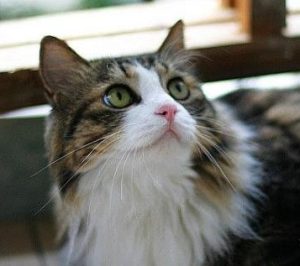Coughing is a common symptom in cats and can be caused by various factors. If your Norwegian Forest Cat is coughing, it’s important to identify the cause and take appropriate action. Here’s a detailed guide on dealing with cat coughing.
Causes of Cat Coughing
Coughing in cats can result from numerous conditions, including pulmonary edema, bronchopneumonia, tracheitis, bronchitis, tracheal paralysis, pharyngitis, allergies, and asthma. Primary coughing is often triggered by colds due to exposure to wind, cold, dampness, or sudden weather changes, which can stimulate the bronchial mucosa and increase mucus production. Infectious diseases like infectious bronchitis and feline tuberculosis can also cause coughing and require thorough examination to identify. Additionally, parasitic infections such as heartworm disease may lead to coughing accompanied by circulatory disturbances, respiratory distress, heart murmurs, anemia, liver enlargement, abdominal swelling, and nodular skin lesions.
Symptoms of Cat Coughing
Feline cough can be categorized into dry and wet cough. Dry cough involves little to no phlegm and is often seen in conditions like acute or chronic pharyngitis, laryngeal cancer, early-stage acute bronchitis, tracheal compression, bronchial foreign bodies, bronchial tumors, pleural diseases, primary pulmonary hypertension, and mitral stenosis. Wet cough, involving phlegm, is common in chronic bronchitis, bronchiectasis, pneumonia, lung abscesses, and cavitary tuberculosis.
Diagnostic Methods for Cat Coughing
To determine the cause of coughing, vets may use X-rays to examine the lungs. Fecal tests can rule out parasitic infections, and bronchoscopy can inspect the airways. Additional tests include:
-
Complete Blood Count: Eosinophilia may indicate asthma or heartworm infection.
-
Bronchoalveolar Lavage: Collects samples for cytological examination.
-
Pleural Fluid Analysis: Important when pleural effusion is present.
-
Heartworm Test: Specific tests and ultrasound can detect heartworms.
-
Tracheoscopy: Observes tracheal abnormalities and collects samples.
Treatment Measures for Cat Coughing
Though coughing itself isn’t life-threatening, it’s crucial to focus on treating the underlying cause. For viral rhinotracheitis, treatments may include:
-
Tetracycline injections (0.1 mg/kg body weight, twice daily, IV)
-
Gentamicin and dexamethasone (10,000 IU/kg body weight and 0.5 mg/kg body weight, respectively, mixed and administered IM twice daily) For conjunctivitis:
-
Cefalexin, dexamethasone, and procaine (0.05 g/kg, 0.5 mg/kg, and 0.15 mg/kg, respectively) mixed for subconjunctival injection daily
-
Alternating chloramphenicol and cortisone eye drops (3 – 5 times daily)
Always consult a vet before administering medication to avoid complications.
Prevention Measures for Cat Coughing
-
Keep cats warm to prevent colds and avoid contact with sick cats.
-
Enhance protection in cold weather.
-
Ensure annual vaccinations and deworming.
-
Isolate cats from allergenic plants.
If your cat’s cough persists or worsens, seek immediate veterinary care for accurate diagnosis and treatment.

